Gold Step is Alfriston (2Y-R) x bulbocodium.
Selfed, presumably, it has produced a number of hybrids with further fertility.
09_09MB is almost fully fertile and has selfed to produce further fertile hybrids similar to itself.
09_14MB has very slight fertility.
Unexpectedly, it has produced a fully fertile hybrid.
10_04MB is fully fertile.
As expected, selfed it can produce fully fertile hybrids.
Gold Step back crossed onto bulbocodiums produces flowers of different colors and sizes. There appears to some fertility in some of these plants.
Gold Step accepts a wide variety of pollens.
Gold Step x N. triandrus (concolor)
Gold Step x 04_01RM (triandrus hybrid) – some of these hybrids have set seed.
Gold Step x N. dubius
The first of the crosses with main division flowers have started. They range from near miniature to beyond intermediate. Small intermediates might well yield miniatures.
Gold Step x 02_191 (near 1O-R).
Gold Step x (Gold Convention x Scipio) – this one has demonstrably significant pollen fertility with small medium and large grains sprouting. I have been hoping these hybrids might have some fertility.
Lastly, Gold Step x (N. fernandesii x Redlands Too), pictured in my previous post.


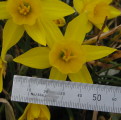
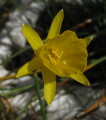
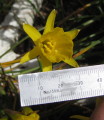
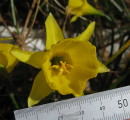
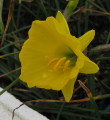
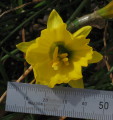


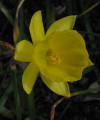

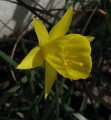

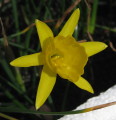
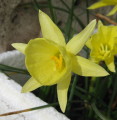
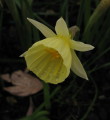
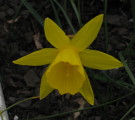


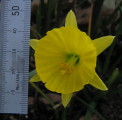
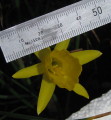
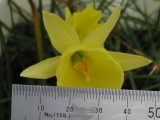
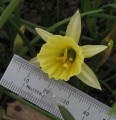
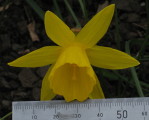





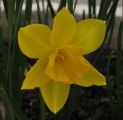
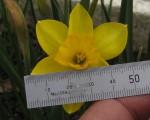
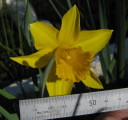
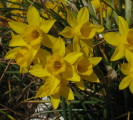
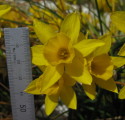

Hi Lawrence,
I wonder which division these cultivars would be registered in.
Then, lets assume these seedlings develop further and you have a bulbocodium corona with fully overlapped perianth segments. It could be Div 2 or 10. I would find it difficult, though, to say Div 12 as it is not inter species crossed.
Dave
Hi Dave,
I’ve registered Gold Step in division 10. My thinking is that traditionally division 5, 7 and 8 hybrids are mostly from species from the contributing sections crossed with main division flowers. Following this principle, main division hybrids with division 10 can be regarded as the NORM for that division. I am aware that not everyone is following this idea.
It’s really difficult, because div. 5 is becoming dominated, not by main division hybrids, but by more triandrus looking hybrids. The same has not happened in divisions 7 and 8 but it might.
Division 9 has always been difficult, in principle, because poets also contribute to divisions 1-3. Division 9 is a lingering relic of the ‘no admixture’ idea. I think this is because poets were rarely seen to be improved in crosses with pseudonarcissus and div.1-3’s generally.
It is easy to suppose that the ‘no admixture’ idea should also be applied to division 10 but, by comparison, there is no such requirement for the pseudonarcissus (div.1-3). I don’t think there is a strong demand for psuedonarcissus without admixture. There would be no orange and probably poor overlap and poor form. I think I recall John Hunter writing that the hispanicus twist in the petals of yellow trumpets should not necessarily be regarded as a fault. I have a very flexible notion of form and don’t disagree with that view, but that said, a flat perianth is very impressive. My feeling, and it’s only a feeling, is that we should register according to what gardeners want to grow and what exhibitors want to exhibit. The ‘no admixture’ bulbocodiums are great but the hybrids have superb floral attributes. They have great vigor, and their broadened perianths and increased size means that the ratio of flower surface area to leaf, stem, and bulb is exceptional. If we regard exhibitors as cutting edge gardeners then a proper place for these hybrids needs to be found.
My own feeling is that the various selfings, intercrosses, and the backcrosses to bulbocodiums, are all division 10. I don’t think this is a perfect arrangement (I don’t think a perfect system is possible) but it is good enough for the current period of breeding and showing.
The crosses with main division flowers, in leaf and appearance, show little evidence of bulbocodium and are therefore main division – mostly intermediates. The crosses with other sections are ambiguous. The dubius and fernandesii hybrids would not be NAS’ed in division 7 but might be acceptable in division 12. I think 12_01MB has special merit and I expect to register it in divison 12. The triandrus hybrids have yet to prove their worth. My main hope at this stage is that they might be a stepping stone to good hardy division 5’s.
I’m rather simple-minded. The blooms with a “bulbocodium-like” cup should be in Division 10. What a dull Division 10 it would be if “no admixture” were the rule and the form of all member cultivars looked nearly the same. Eventually there would come a revolt against restriction, such as has occurred with color in Division 9. Many disagree with me – in the UK there was a suggestion to remove cultivars such as ‘Little Soldier’ from Division 10, apparently as being too far from the form of the species.
I find these little flowers very appealing, especially the ones with the more spreading cup. Lovely!
Thanks Denise/Neil, Bob.
I’ve just added to the post – a seedling that is Gold Step x 2Y-O. This is exciting for me because it is the first of crosses with main division flowers to show significant fertility..
My wife’s favorite of the concolorous daffodils is Dreamspell which consistently has petals that curl to the right providing a pinwheel mimic. As she has now just allowed her 10th cultivar in the yard, she is quite fussy about color and form. She likes uniform twist, but quite pronounced. She however is NOT a judge but is quite observant of the daffodils if not only by osmosis.
As the flower is produced by selfing, one could have an unreduced gamete, or a paired one. Either way quite exciting! The fertility aspect alone is exceptional.
In regards to Form in Div 10 there is considerable variability in petal size. That said if there is sufficient development in the division, the div 10 could be classed as flowers with petals smaller in mass than the corona. Div 1-4 is form Div 10 could be likewise ans a new division could result if the flowers strayed too far from ‘standard’
To my eye the most attractive ones have rounded spreading corona and uniform segments. I too like the flat ones though twisted appeals. Our current problem locally is that they are indoor plants and hardiness would also be a big deal for the northern tier. You may also defeat this problem as well and we could have the huge floral mass that this tribe produces in our gardens each Spring
I like 14 10MB – the cup shape is lovely, and the yellow colour has a subtle greenish tinge that I find more attractive than the brighter yellows. I also like 13 42MB – again it’s a beautiful cup shape with delicate colouring. I guess I just know what I like (chuckle). In any case, I’d have no problem buying either of these if I saw them in a commercial catalogue.
Ciao, Jacq.